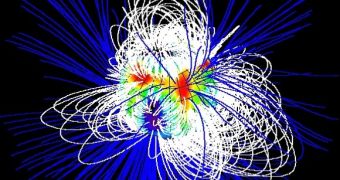Researchers at the Paris Observatory in France have managed to discover faint magnetic fields around young stars, which seem to originate back in the time of the Big Bang, they say. The stars are yet too young to have formed a field of their own, and the team is convinced they have come across a strong evidence of the fact that the big explosion at the beginning of our Universe indeed created magnetic fields. This theory has been disputed for a very long time, and critics have always said that palpable evidences have been missing.
Now, if this discovery turns out to be true, it could mean a potential reshaping of our understanding of the origins of the Universe. If magnetic fields were indeed created at the time of the Big Bang, then certainly some of them were stronger than others. This may have caused the newly-formed Universe to move in one direction more than the other, which would imply that it's not symmetric on either side of its central point, but that it can have any shape.
These trace magnetic fields have been identified around main sequence A/B stars, very young celestial bodies, which have been observed via the Canada-Hawaii-France Telescope on Mauna Kea, in Hawaii. And while the team, led by Claude Catala, claims that their find proves the existence of a primordial magnetic field, others, such as Francesco Miniati, from the Swiss Federal Institute of Technology, in Zurich, Switzerland, argue that they agree with the new study, but find the evidence inconclusive.
“It would if we also knew that these stars were primordial first stars, which they are not,” Miniati says. In reply, Catala maintains that there are no telescopes on Earth or in orbit that are sensible enough to see the first stars, which are by now several billions of light years away. Nor, he adds, are such telescopes planned for the near future.
Catala also admits that there's a chance these magnetic fields are not primordial, but emphasizes that “This [the find] is completely in agreement with the fossil field theory,” and that the field “could indeed be primordial.” At the very least, the new discovery points out the fact that stellar dynamo mechanisms are not responsible for these magnetic fields, as others suggested in the past.

 14 DAY TRIAL //
14 DAY TRIAL //